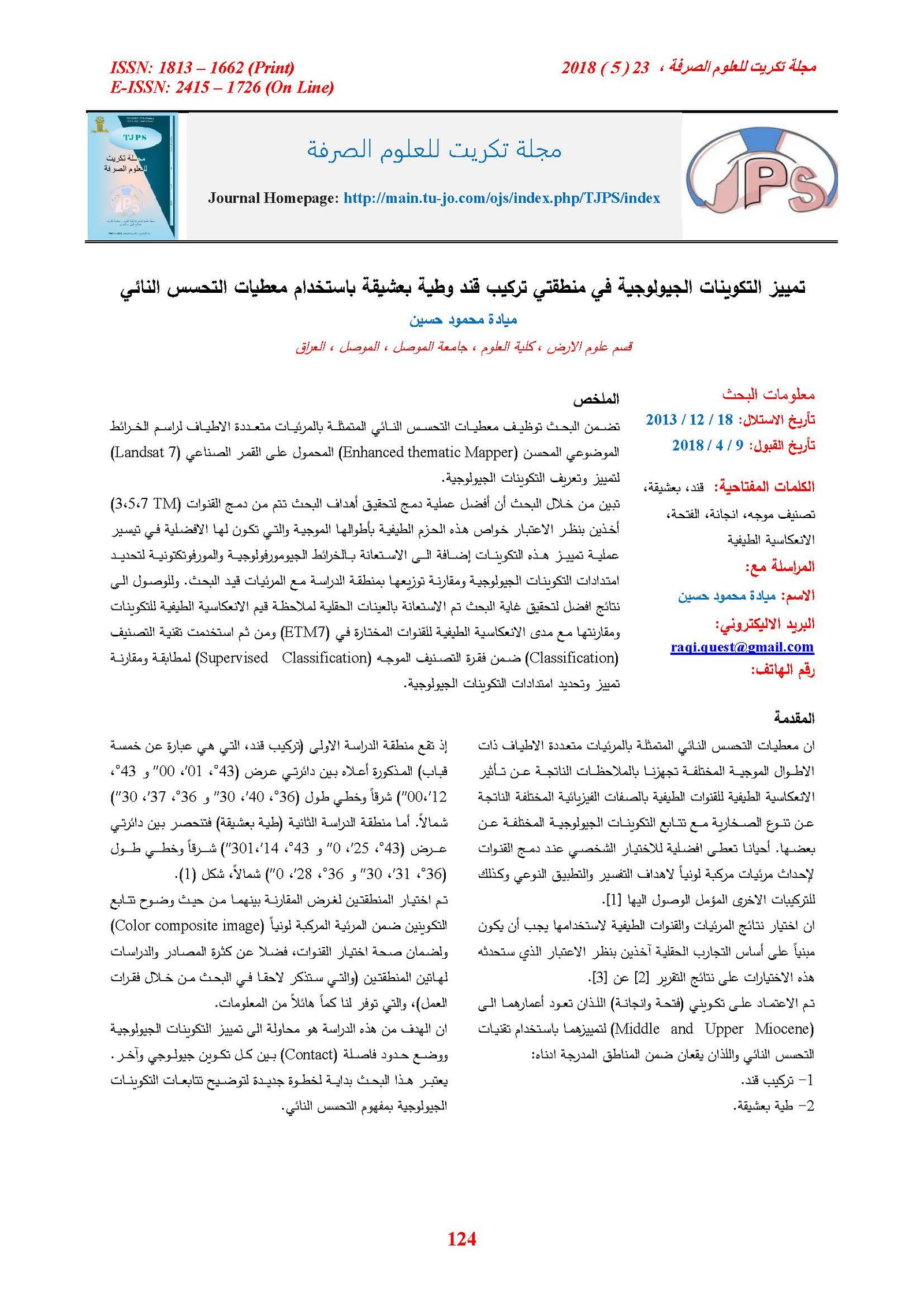Distinction Geological Formations at Qand Structure And Bashiqa Anticline Localities Using Remote Sensing Data.
Main Article Content
Abstract
The research project includes the use of remote sensing data such as multispectral images of Enhanced thematic mapper on board of "Laudsat 7" for the purpose of distinguishing and defining the geological formations it has been shown that in order to achieve the purpose of the research project, an incorporation of the channels TM (7, 5, and 3), was carried out. These spectral bauds with their wavelengths have a bigger preference over other bands in distinguishing between the geological formations. The results are further supported by geomorphological and morphotectonical maps for the limitation of the extensions of the formations and the comparison of these extensions with the study locality. Field specimens were used for the observations of spectral reflections of the selected (ETM7), channels, supervised classification was also used for the correlation, characterization, and limitation and the extension of the geological formations.
Article Details

This work is licensed under a Creative Commons Attribution 4.0 International License.
Tikrit Journal of Pure Science is licensed under the Creative Commons Attribution 4.0 International License, which allows users to copy, create extracts, abstracts, and new works from the article, alter and revise the article, and make commercial use of the article (including reuse and/or resale of the article by commercial entities), provided the user gives appropriate credit (with a link to the formal publication through the relevant DOI), provides a link to the license, indicates if changes were made, and the licensor is not represented as endorsing the use made of the work. The authors hold the copyright for their published work on the Tikrit J. Pure Sci. website, while Tikrit J. Pure Sci. is responsible for appreciate citation of their work, which is released under CC-BY-4.0, enabling the unrestricted use, distribution, and reproduction of an article in any medium, provided that the original work is properly cited.
References
[1] Lillesand , T.M. and Kiefer , R.W., 1987. Remote sensing and image inter-pretation, 3 nd Ed. John Willey and Sons incop.
[2] Al- Daghastani, H.S. and Salih, M.R., 1993. Adjustment of the Khazir to the Style of Structural Deformation Using Remote Sensing Data. Iraqi Geological Jour., Vol. 25, No. 1, pp 65-79.
[3] Jensen, John R., 2007. Remote sensing of the Environment, an Earth Re-source Perspective, 2nd , Pearson Prentice, Hall, 592p.
[4] AL- Daghastani, H. S., 2004. Principles of Remote sensing and Image interpretation, University of Mosul, Remote sensing center, P 526.
[5] AL- Banaa, R. g. th., 2002, Geomorphology of Qand, structure Northern Iraq Using Remotes sensing Techniques, University of Mosul, college of science, P 119.
[6] Harris, d. R., Eddy, B., Rengz, A., 1998. Remote sensing as a Geological Mapping tool in the Arctic: Preliminary Result from Baffin Island Nunavut, Geological survey of Canada, PP 1-22.
[7] Sabins, JR. F., 1987. Remote sensing : Principles and Interpretation. Free-man Sons Co., San Francisco, USA., 426p.
[8] Al-Khafaji, M.W. A., 2004. Sedimentological study of Tramsitional zone Between Marine and Non- Marine Sediments within Fat ha formation (Middle Miocene) in selected University of Mosul, College of science, P 144.
[9] Buday ,T., (1980). The regional geology of Iraq (Stratigraphy paleontology) Dar AL-Kutib publishing House, Mosul, Iraq,443 p.
[10] Othman, S. M., 1990. Distribution of Major- Minor and Trace Elements mineral constitunts of the sediments of the upper, Mosul, University, College of Science P. 132.
[11] Al- Rashidy, M. A. M., 2004. Sedimentological study of injana formation in kand Fold. North Iraq. Northen Iraq, University of Mosul, P. 153.
[12] Youssef, A.M., Zaghloul, F.M., Moussa, Mohdi, A.M., 2009. Lithological Mapping Using Landsat Enhanced Thematic Mapper in the Central Eastern Desert, Egypt: Case Study: Area Sturound Gabal Egypt. Jou., Remote Sensing and Space Science, Vol. 12, pp. 87-100 (2009)
[13] Kavhko Jukka, Wirsley Peter., 1996. Quantitative Mapping of Active Aeolian Surfaces in Northern Fennoscandia Landsat TM Hybrid Classification. Postgraduate Research Institude For Sedimentology, The University, White Knights, P.O. Box 227, Reading RGB, England. Proceeding of the Fourth Symposlum on the Remote Sensing of the Polar Environments, Lyngby, Denmaerk, pp. (147-152), 29-April-1May 1996.
[14] Dhanvi, Artimes Ghassemi, Surikhani, Ramin Nagagarim, D., 2010. Image Processing and Analysis of Mapping Altertion Zones in Environmental Research, East of Kurdistan, Iran. World Applied Sciences Journal, Vol. 3, pp 278-283.
